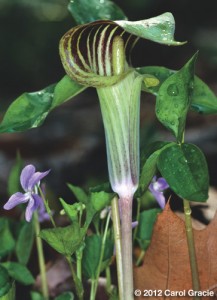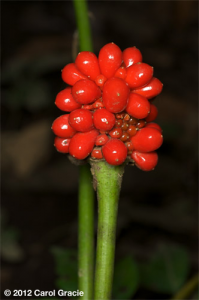Jack-in-the-pulpit: Pollination by Deception
Posted in Around the Garden, Science on June 12 2013, by Carol Gracie
After spending nearly three decades at the NYBG, and working much of that time in South American rainforests with her husband, Scott A. Mori, Carol Gracie has returned to one of her first botanical interests–local wildflowers. She is the author of Spring Wildflowers of the Northeast: A Natural History and coauthor (with Steve Clemants) of Wildflowers in the Field and Forest: A Field Guide to the Northeastern United States.

One of our easiest to recognize wildflowers is Jack-in-the-pulpit (Arisaema triphyllum). Named for its fancied resemblance to a preacher (“Jack”) in his over-hanging pulpit, the name captures the imagination and makes the plant easy to remember. Like other members of the aroid family (Araceae) the inflorescence is comprised of two parts: a spadix that bears numerous small flowers and a modified leaf called a spathe that surrounds and partially encloses the spadix. In the case of Jack-in-the-pulpit, each plant bears either male or female flowers; the plants are dioecious.
Other aroids can have different arrangements of their flowers; for example the flowers of skunk cabbage (Symplocarpus foetidus) are perfect, meaning that every flower has both male and female parts, while those of the European wildflower known as lords and ladies (Arum maculatum), are arranged with separate male flowers on the upper part of the spadix and female flowers on the lower part.
[Not a valid template]The flowers are simple: male flowers are comprised of only four stamens, and female flowers of a fuzzy stigma atop an ovary. Jack-in-the-pulpit is pollinated by fungus gnats, which are attracted into the hooded spathes by a slight fungal odor. The gnats visit to lay their eggs on what they are duped to believe is a fungus. Fungus gnats normally lay their eggs on fungi so that when the eggs hatch the larvae will have a readily available food source. When the mistake is perceived the gnats are unable to crawl out of the spathe due to its slippery interior, nor can they fly straight up to escape in that way. However, if the plant is a male, they may eventually notice a small opening at the base of the spathe through which they can escape. By this time they are dusted with pollen.

The gnats, being of limited brain capacity, may be duped repeatedly until they eventually enter a female plant where the pollen that they are carrying brushes off on the fuzzy stigmas, thereby effecting pollination. This time there is no escape since the spathes of female plants have no opening in the base of their spathes, and the gnats die within the spathe.
The ovaries ripen into bright red berries that are evident in the forest during late summer and fall.
Read more about Jack-in-the-pulpit and other wildflowers in my book, Spring Wildflowers of the Northeast: A Natural History, available in the New York Botanical Garden Shop.

